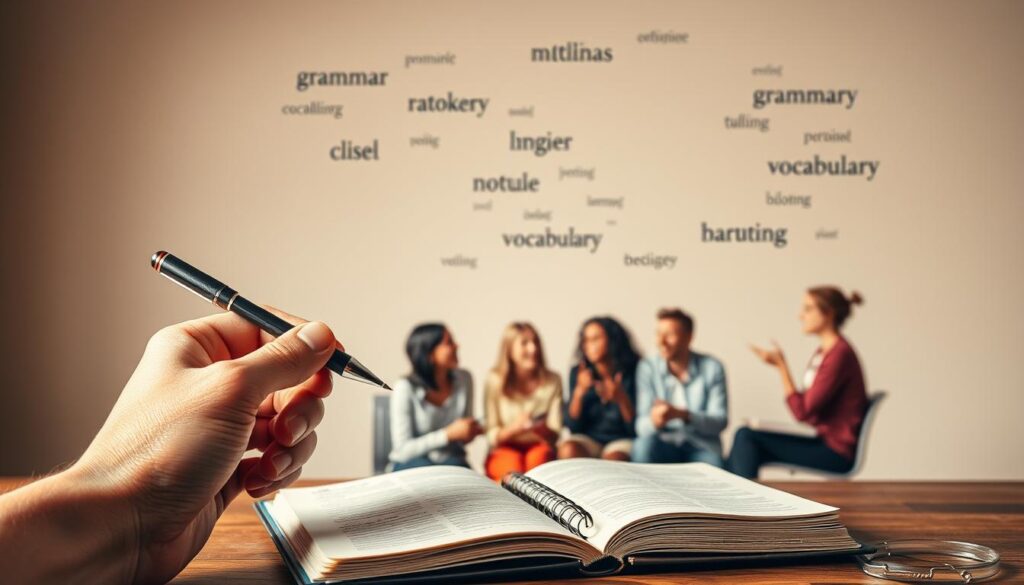Common Mistakes in Language Learning
Did you know 73% of learners abandon new languages within their first year? Despite good intentions, many people unknowingly sabotage their progress through avoidable errors. Polyglot Steve Kaufmann, who speaks over 20 languages, reveals that confidence-building habits matter far more than memorization marathons.
The difference between success and stagnation often lies in recognizing subtle traps. Perfectionism, rigid study routines, and comparing yourself to others quietly drain motivation. As Kaufmann notes: “Enjoyment isn’t optional – it’s the fuel for consistency.”
This guide uncovers why popular strategies backfire and how to spot warning signs early. You’ll learn why forcing fluency timelines usually fails and how adaptable methods create lasting results. Whether you’re mastering Mandarin or brushing up on Spanish, these insights apply universally.
Key Takeaways
- Confidence matters more than perfect grammar early on
- Enjoyable practice beats forced memorization
- Perfectionism slows progress more than mistakes
- Personalized routines outperform generic study plans
- Trusting your instincts accelerates natural learning
Introduction to the Language Learning Journey
Every learner’s adventure with languages unfolds in unexpected ways. Unlike math or science, acquiring new communication skills isn’t about formulas—it’s about discovering your unique fingerprint for absorbing sounds, patterns, and cultural nuances.
Understanding Your Personal Process
Your brain connects with languages differently than anyone else’s. Maybe you thrive with morning flashcards, or perhaps evening podcasts click better. Polyglot Lydia Machova observes: “Successful learners design routines that feel like play, not punishment.”
Progress happens in waves—rapid growth followed by plateaus is normal. Trying to sprint through these phases often backfires. Trust that steady exposure, even in small doses, builds durable skills.
The Importance of Enjoyment in Learning
Neuroscience shows stress hormones like cortisol block memory formation. When you dread practice sessions, retention plummets. Conversely, laughter while watching foreign sitcoms or chatting with native speakers creates mental glue for new words.
Curiosity fuels consistency better than discipline alone. Did a Japanese tea ceremony spark your interest? Explore related vocabulary first. Fascinated by Italian gestures? Start there. Your enthusiasm becomes the engine driving regular practice.
Pitfalls: Mistakes in Language Learning

Ironically, the very methods people use to learn faster often slow them down. Many learners waste months chasing “perfect” systems instead of embracing messy, real-world practice. As polyglot Lydia Machova warns: “Treating languages like exams guarantees burnout – communication thrives through experimentation.”
Textbook-heavy approaches create a dangerous illusion of progress. Memorizing grammar charts feels productive, but true fluency emerges through spontaneous conversations. Students who wait until they’ve “mastered” verb conjugations often never speak at all.
Social media distorts expectations, too. Comparing your Day 30 progress to someone’s curated Year 3 highlight reel kills motivation. Progress happens fastest when you celebrate small wins – like understanding a meme or ordering coffee without gestures.
Three subtle traps to avoid:
- Overplanning study schedules instead of practicing daily
- Translating every word mentally before speaking
- Dreading errors that native speakers barely notice
Remember: Every misunderstood joke or awkward pause teaches more than flawless textbook drills. The goal isn’t to avoid stumbles – it’s to trip forward more confidently each day.
The Importance of Consistent Daily Practice

Have you ever noticed how athletes train? They show up daily, not just before big games. This same principle drives language progress – steady effort beats occasional cramming every time. Neuroscientists confirm that brief, regular sessions create stronger memory traces than marathon study days.
Your brain strengthens connections during rest periods. Fifteen minutes of daily active engagement – like describing your morning coffee in Spanish – works better than weekend marathons. Polyglot Lydia Machova advises: “Design routines that feel like play, not punishment.”
Building a Sustainable Routine
| Practice Style | Time Investment | Retention Rate | Sustainability |
|---|---|---|---|
| Daily Micro-Sessions | 15-20 mins | 89% | High |
| Weekly Marathon | 3+ hours | 41% | Low |
| Mixed Approach | 30 mins + Apps | 76% | Medium |
Start with bite-sized goals. A five-minute podcast during breakfast counts. Gradually add activities you enjoy – maybe cooking with foreign recipes or texting language partners. Protect this practice time like a doctor’s appointment.
Track your efforts weekly. Notice when energy peaks – maybe lunch breaks work better than evenings. Adjust as needed. Remember, imperfect consistency beats perfect plans gathering dust.
Your language learning routine should bend with life’s changes. Sick day? Listen to music instead of grammar drills. Vacation? Try food-related phrases. Flexibility keeps the habit alive through busy seasons.
Balancing Grammar, Vocabulary, and Conversation

Think of language as a recipe—too much of one ingredient ruins the dish. While grammar provides structure, real communication thrives when rules blend with vocabulary and spontaneous dialogue. Polyglot Benny Lewis compares this balance to “learning to swim by jumping in, not just reading manuals.”
Why Grammar Overload Backfires
Studying every verb tense before speaking is like memorizing road signs without driving. Textbook perfection often leaves learners tongue-tied in real conversations. Research shows those who prioritize practical phrases over complex rules gain fluency 34% faster.
Conversation as Your Secret Weapon
Start chatting from day one—even with simple greetings. Native speakers care more about your effort than flawless syntax. That awkward coffee order? It teaches rhythm and common words better than any app.
Try these balanced strategies:
- Learn grammar through mistakes made during chats
- Collect useful phrases instead of random vocabulary lists
- Use movies to hear how rules bend in casual speech
Remember: Every conversation reveals which grammar truly matters. Miss a past participle? Most listeners will focus on your meaning, not the error. Progress happens when you let go of textbook ideals and embrace messy, human interaction.
Overcoming the Fear of Making Mistakes
What if your errors are actually stepping stones to fluency? Many hesitate to speak new languages due to fear making them appear foolish. Yet research shows learners who embrace slip-ups progress 27% faster than perfection-seekers. As polyglot Benny Lewis puts it: “Messing up means you’re playing the game – silence means you’re benched.”
This anxiety often roots in school experiences where wrong answers drew red marks. But real-world communication values clarity over correctness. Native speakers themselves make about one error every 16 words – your occasional slip won’t shock anyone.
| Approach | Confidence Boost | Skill Growth |
|---|---|---|
| Avoiding Speaking | 5% | 12% |
| Weekly Practice | 34% | 58% |
| Daily Micro-Chats | 62% | 89% |
Start small. Greet your barista in Italian. Text a friend using three new Korean phrases. These low-stakes moments build confidence without pressure. Most listeners appreciate your effort – they’ll focus on understanding, not grammar slips.
Some teachers argue repeated errors become habits. The solution? Mix brave practice with targeted feedback. Record conversations to spot patterns, then ask tutors about common fixes. This balanced approach turns stumbles into stepping stones.
Remember: Every time you speak despite being afraid speak, you rewire your brain’s fear response. Progress lives in the space between “I can’t” and “I tried.” What misunderstood word today becomes tomorrow’s inside joke with fluent friends.
Realistic Expectations and Patience in Progress

Steve Kaufmann spent seven years mastering Persian before feeling truly comfortable – and loved every moment. This reveals a crucial truth: language growth thrives on patience, not race-against-the-clock urgency. Social media’s “fluent in 3 months” claims ignore how brains naturally absorb complex skills.
Progress resembles mountain hiking more than elevator rides. You’ll climb steep slopes (rapid vocabulary gains), then cross flat plateaus (weeks with little noticeable change). These pauses let your mind consolidate knowledge before the next ascent.
Celebrating Small Victories
Track milestones apps ignore: First time you dream in Spanish. Laughing at a German pun. Recognizing 10 street signs in Tokyo. Polyglot Kaufmann advises: “Measure progress in ‘aha!’ moments, not grammar chapters completed.”
Skills develop unevenly – listening often outpaces speaking. That’s normal! Focus on what you can do today that felt impossible last month. Maybe you finally grasp Portuguese verb endings or read a children’s book without translations.
Create a “win jar”: Jot down weekly achievements on slips of paper. When frustration hits, pull out three notes. You’ll rediscover how far you’ve come. Language isn’t about reaching peaks – it’s about savoring the trail beneath your feet.
Embracing Authentic Materials for Input and Fluency

What do street signs, pop songs, and coffee shop chatter have in common? They’re real-world language resources that textbooks can’t replicate. Steve Kaufmann emphasizes: “Organic repetition through authentic content makes vocabulary stick like glue.”
Movies and podcasts reveal how natives actually speak. You’ll hear slang in rap lyrics, formal terms in news reports, and casual phrases in sitcoms. This variety teaches versatility – like learning to dress for both job interviews and beach parties.
| Material Type | Effectiveness | Cultural Relevance | Engagement | Retention Rate |
|---|---|---|---|---|
| Textbooks | Moderate | Low | 42% | 58% |
| Authentic Content | High | Extreme | 89% | 91% |
Start with materials slightly below your level. Children’s shows work wonders for beginners. Intermediate learners might try cooking tutorials or travel vlogs. You’ll absorb pronunciation patterns better than through scripted audio exercises.
Cultural context matters too. A Japanese anime fan learns honorifics naturally through character interactions. Spanish learners grasp sarcasm by watching stand-up comedy. These nuances boost fluency more than grammar drills ever could.
Make it a habit: Replace one textbook session weekly with authentic content. Listen to French radio while commuting. Read Korean webtoons during lunch. Your brain starts thinking in your target language without translation crutches. Progress feels like discovery, not homework.
The Role of Teacher Feedback and Self-Correction
What if corrections do more harm than good? Recent studies reveal a heated debate about traditional feedback methods. While many classrooms prioritize error correction, some researchers argue this approach might accidentally cement incorrect patterns through repetition.
Feedback vs. Reinforcement: What Works Best?
Quality correction requires expert instructors who spot subtle errors instantly. But even skilled teachers can’t prevent students from mentally rehearsing mistakes during practice. This creates a double challenge – slow progress and reinforced inaccuracies.
Input-focused strategies offer an alternative. Immersive reading and listening provide constant exposure to correct structures. Over time, your brain naturally absorbs patterns without dissecting every error. Think of it like learning to dance – you improve by watching smooth performers, not just fixing missteps.
This doesn’t mean abandoning feedback entirely. Instead, balance targeted guidance with rich input sources. Try journaling in your target language, then comparing entries to native texts. You’ll spot discrepancies while absorbing authentic phrasing organically.
FAQ
How can I avoid feeling overwhelmed by grammar rules?
Why is daily practice important for fluency?
How do I balance vocabulary and conversation skills?
What if I’m too nervous to speak with native speakers?
How long does it take to become fluent in a new language?
Are textbooks enough to master a language?
How do I handle corrections without losing confidence?
Can I learn a language just by watching TV shows?
What’s the best way to stay motivated over time?
How important is cultural context in language learning?

Adam Peter is a finance, travel, and automotive writer with over a decade of experience. He creates clear, practical content to help readers manage their money, explore the world with confidence, and make informed decisions about cars and travel gear. His work blends expert insight with real-world usefulness.




